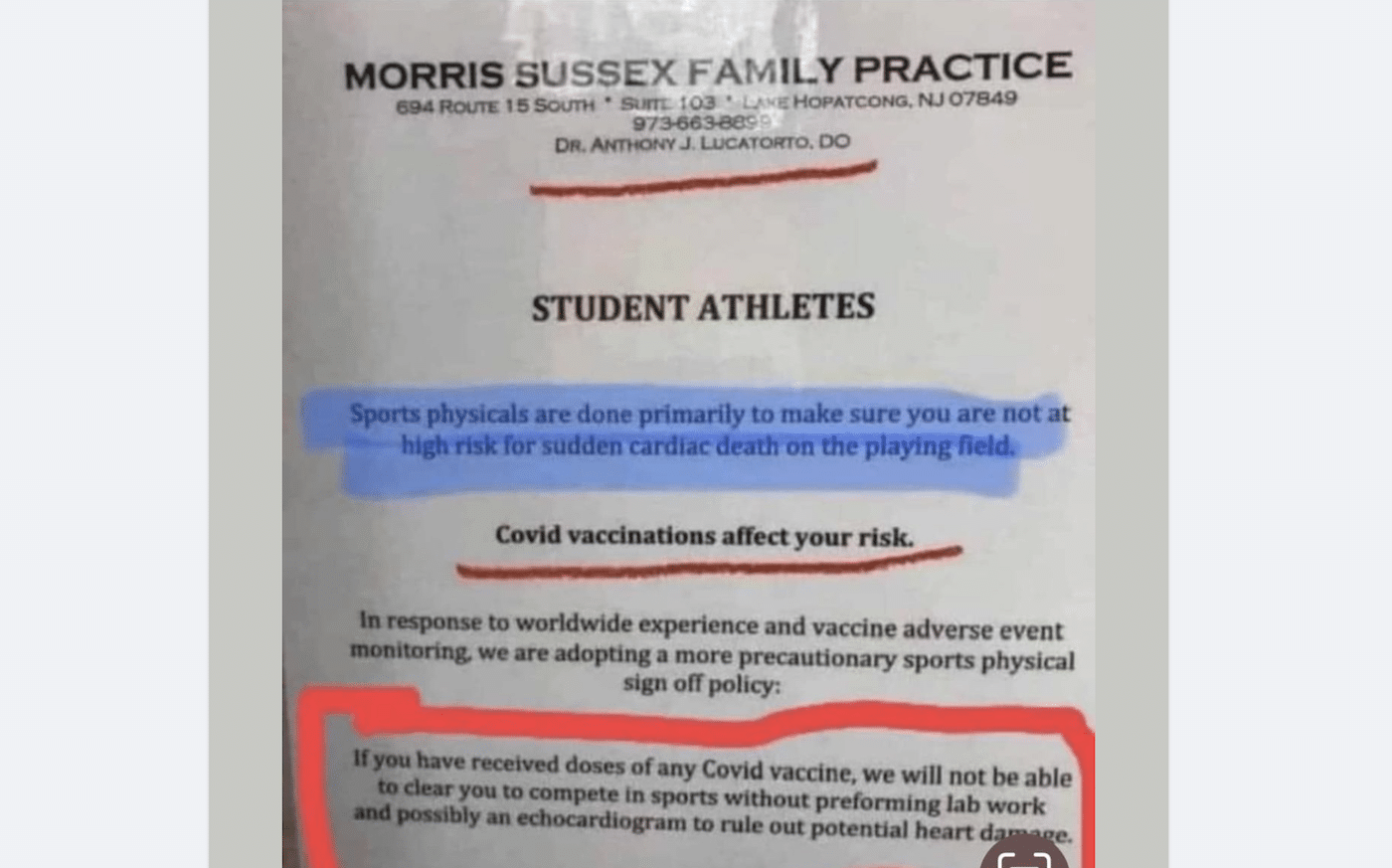- Health
SADS is caused by genetic mutations affecting the electrical system regulating heartbeat; no evidence it is caused by COVID-19 vaccines
Key takeaway
Reports of sudden arrhythmia death syndrome (SADS) date back to the early 1990s. SADS is the result of genetic mutations that disrupt the electrical system that regulates the pumping action of the heart. This can lead to abnormal heart rhythm (arrhythmia) and sudden cardiac arrest. Some people who have these conditions may not exhibit any symptom at all; others may be prone to seizures as well as fainting under physical or emotional stress. The SADS Foundation recommends that people with SADS conditions get the COVID-19 vaccine.
Reviewed content
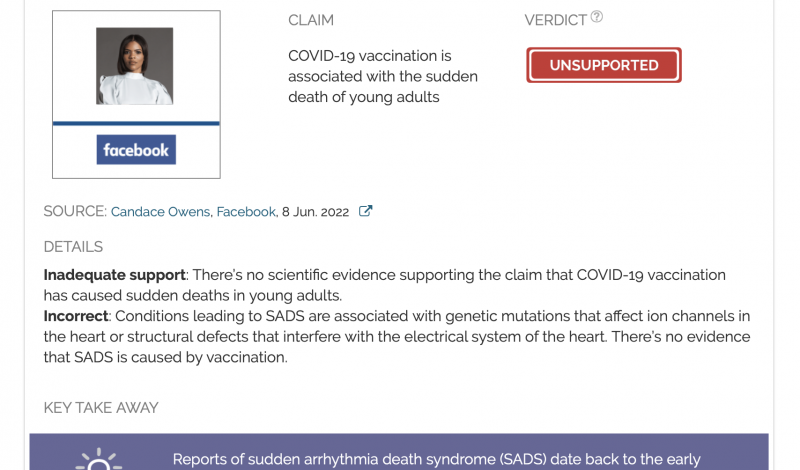
Verdict:
Claim:
COVID-19 vaccination is associated with the sudden death of young adults
Verdict detail
Inadequate support: There’s no scientific evidence supporting the claim that COVID-19 vaccination has caused sudden deaths in young adults.
Incorrect: Conditions leading to SADS are associated with genetic mutations that affect ion channels in the heart or structural defects that interfere with the electrical system of the heart. There’s no evidence that SADS is caused by vaccination.
Full Claim
“Just wanted to publicly state that my children are and will remain completely unvaccinated and that I truly wish my parents had made different decisions for me. In other news—have you read about how young adults are dying suddenly and it’s a complete mystery to doctors as to why that’s happening?”
Review
On 8 June 2022, political commentator Candace Owens shared a Daily Mail article on Facebook, which carried the headline “Sudden deaths of young people proving a mystery for doctors”. In the caption of the post, she commented that she “Just wanted to publicly state that [her] children are and will remain completely unvaccinated”. She also posed this question to her audience: “[H]ave you read about how young adults are dying suddenly and it’s a complete mystery to doctors as to why that’s happening?”
Owens’ comment about her children remaining unvaccinated coupled with the Daily Mail headline communicated to readers that the “sudden deaths” are related to COVID-19 vaccination. Indeed, we found numerous Facebook users who commented on Owens’ post, claiming that vaccination is unsafe.
In response to a fact-check by PolitiFact, Owens defended herself in a comment, stating that she “did not say the vaccines were linked to SADS. I said there was a new ‘mystery’ illness”.
However, even that comment is inaccurate. SADS isn’t a “new ‘mystery’ illness”; reports of SADS date back to the early 1990s[1]. And as we pointed out above, Owens’ post generated multiple comments inaccurately claiming that vaccines are unsafe, illustrating that her post can and did mislead users. The phrasing of part of her post as a question is a typical example of the rhetorical tactic known as “just asking questions”, which enables someone to ask leading questions and posit baseless or disproven hypotheses without having to provide evidence. It’s not the first time Owens did so; she also baselessly suggested that American comedian Bob Saget died because of the COVID-19 vaccine.
Others were more explicit about associating the Daily Mail article with COVID-19 vaccines, such as climate change skeptic Joanne Nova.
But the narrative that many healthy and even athletic young people are suddenly dropping dead because of COVID-19 vaccines is not new; it’s a popular one that can be traced back to those opposing COVID-19 vaccination. Multiple fact-checkers reported on unsubstantiated claims propping up this narrative, which went viral in late 2021, such as Reuters, The Washington Post, PolitiFact, FactCheck.org.
The popularity of this narrative likely has to do in part with the fact that certain COVID-19 vaccines, namely the Pfizer-BioNTech and Moderna vaccines, are associated with an increased risk of heart inflammation, thereby providing a grain of truth to the narrative. But those promoting this narrative generally gloss over the fact that getting COVID-19 itself is much more likely to cause heart damage, in addition to other health problems like long COVID, than the vaccines.
At any rate, there isn’t evidence supporting the narrative that there’s been an unusual spike in the number of healthy young people dying suddenly. For example, FIFA, the highest governing body of association football, told Reuters that they were “not aware of a rise in episodes of cardiac arrests” and that “no cases have been flagged in relation to individuals receiving a COVID vaccine”.
By reading the Daily Mail article itself, we learn that the story was based on a news.com.au report about a woman’s death from sudden arrhythmia death syndrome (SADS) and the setting up of a registry to record SADS cases in Australia. Neither the Daily Mail nor news.com.au mentioned vaccines nor claimed that there has been an unusual spike in “sudden deaths of young people”. And yet Owens wasn’t the only person to share the Daily Mail story and stoke many vaccine-skeptic responses, as evidenced by these social media posts here and here, demonstrating the article’s ability to mislead online users.
Sudden arrhythmia death syndrome (SADS), sometimes incorrectly called sudden adult death syndrome, occurs in young, apparently healthy people under the age of 40 as the result of sudden cardiac arrest.
According to the SADS Foundation, SADS is the result of genetic mutations that disrupt the normal functioning of the electrical system that regulates the pumping action of the heart. There are several conditions that can cause SADS, such as long QT syndrome, Brugada syndrome, and Timothy syndrome. These conditions can produce arrhythmia, or abnormal heart rhythm, which can lead to sudden cardiac arrest. Some people who have these conditions may not exhibit any symptom at all, while others may be prone to seizures as well as fainting under physical or emotional stress.
The heart’s pumping action is regulated by electrical impulses, which are generated by the sinoatrial node, also called the heart’s natural pacemaker (Figure 1).
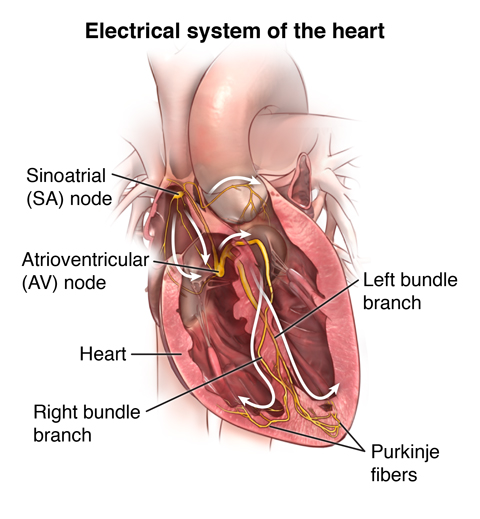
Figure 1. Image shows the different parts of the heart involved in the transmission of electrical signals that regulate the heart rhythm. Source: Johns Hopkins Medicine.
Electrical impulses are produced by the movement of ions, specifically potassium, calcium, and sodium ions, across cell membranes through ion channels (Figure 2). Some of the conditions associated with SADS involve a dysfunction in ion channels or insufficient ion channels. Others involve structural heart defects that disrupt the heart’s normal electrical system, like arrhythmogenic right ventricular dysplasia, in which the heart muscle on the right ventricle is replaced by fat or fibrous tissue.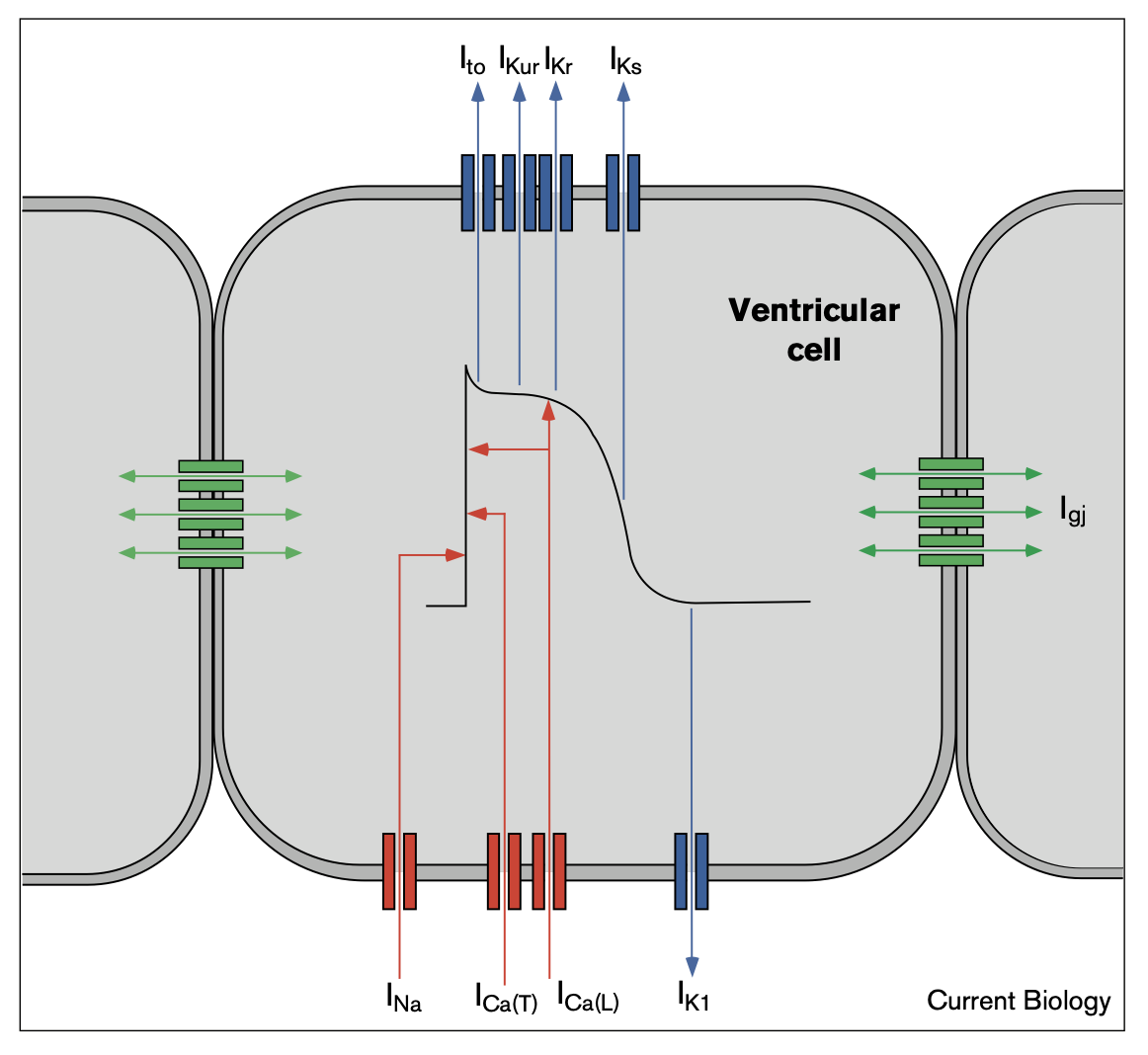
Figure 2. Simplified representation of ion channels in cells of the heart (specifically the heart ventricles)[2]. Na: sodium, Ca: calcium, K: potassium.
As explained above, these problems arise due to genetic mutations. There’s no evidence that SADS is caused by COVID-19 vaccination. Indeed, the SADS Foundation recommends that people with conditions associated with SADS get the COVID-19 vaccine. Assertions that SADS was unknown or unheard of before the COVID-19 vaccines were widely used are false. In fact, reports of SADS date all the way back to the early 1990s[1].
Nor is there evidence that SADS is becoming a leading cause of death in young people, even if media like the Daily Mail and vaccine misinformation feed that perception. At the moment, population data on the leading causes of death generally aren’t available for 2021 and 2022, making such a claim premature and unverifiable at this time. But to provide context, we included some official statistics below to help readers understand the numbers behind the leading causes of death in young people in the U.S. and in Australia.
In the U.S., the latest report by the Centers for Disease Control and Prevention is for 2020. The report found that “In the first half of life, more Americans die from injuries and violence—such as motor vehicle crashes, suicide, or homicides—than from any other cause, including cancer, HIV, or the flu. This makes injury the leading cause of death among persons aged 1-44.” Specifically, more than 80,000 deaths in 2020 were due to injury.
And among children and adolescents, defined as people between the ages of one to 19, deaths due to firearm-related injuries were the most common cause of death in 2020 (more than five in 100,000 children and adolescents), according to an analysis in the New England Journal of Medicine[3]. The next leading cause of death was motor vehicle accidents.
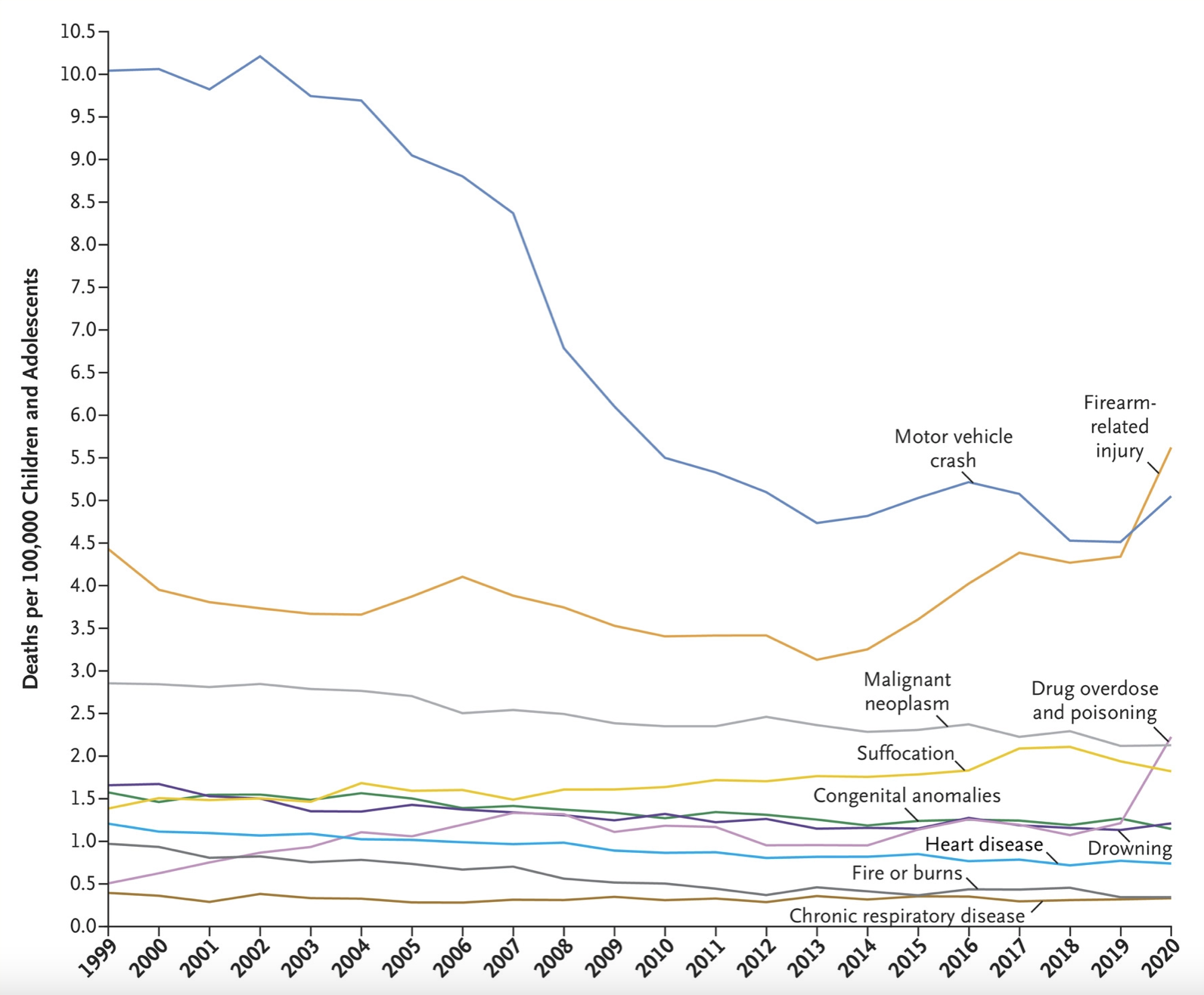
Figure 3. Top ten leading causes of death in children and adolescents from 1999 to 2020 (age 1 to 19 years old)[3].
As in the U.S., the latest report on the leading causes of death in Australia only extends as far as 2020. The Australian Institute of Health and Welfare reported that for the age group between 15 and 44, suicide and accidents were the leading causes of death.
According to the American Heart Association, “over 320,000 out-of-hospital cardiac arrests occur annually in the United States”. A report published in 2020 in Circulation: Cardiovascular Quality and Outcomes about sudden cardiac deaths in young people in Australia found that “Incidence ranges globally between 1.3 and 2.9 per 100 000 person-years”, although this depends on factors such as age group. It also found that SADS was the second most common cause of sudden cardiac deaths in the young (14%)[4].
It remains to be seen how the COVID-19 pandemic will influence these trends. However, having reliable data for making comparisons about the leading causes of death during the pandemic will take time.
REFERENCES
- 1 – Behr et al. (2007) Sudden arrhythmic death syndrome: a national survey of sudden unexplained cardiac death. Heart.
- 2 – Jongsma HJ. (1998) Sudden cardiac death: A matter of faulty ion channels? Current Biology.
- 3 – Goldstick et al. (2022) Current Causes of Death in Children and Adolescents in the United States. New England Journal of Medicine.
- 4 – Ha et al. (2020) Sudden Cardiac Death in the Young: Incidence, Trends, and Risk Factors in a Nationwide Study. Circulation: Cardiovascular Quality and Outcomes.

